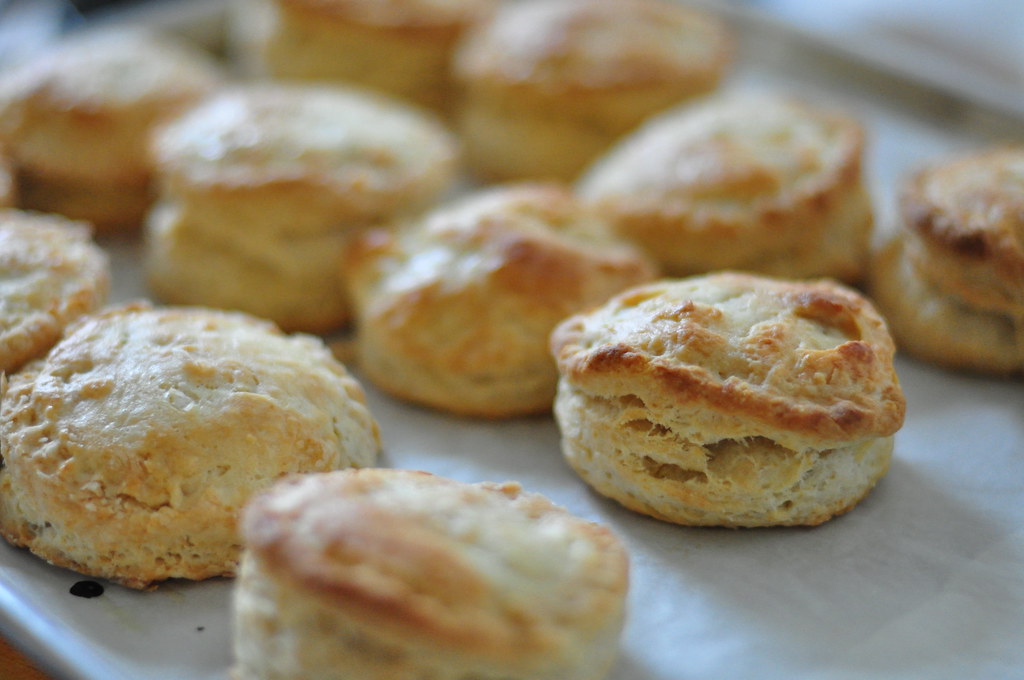FARMGIRL AT HEART: The history of biscuits and Aunt Ida’s recipe

 by Virginia Jones
by Virginia Jones
What comes to your mind when you hear the word biscuit? Depending on where you live it means different things. In the South, biscuits would be a light and fluffy staple at the dinner table. In the North, the biscuit would be a hardy companion for a hot bowl of fish chowder. If you lived in Europe, you might have a biscuit to accompany your tea time.
So, where did the idea of a biscuit actually originate? In the Medieval times a biscuit was more like what we now know as Biscotti. There was no baking soda or baking powder to be had and so therefore the biscuit would be flat. By 1588 Roman soldiers were eating biscuits as part of their daily meal. If you were a sailor of the British Royal Navy, then the term “hardtack” was a familiar one. Hardtack or a flat biscuit was made using flour, water and salt. It was baked at least four times and made up to six months in advance so that by the time a ship sailed, it was good and ready to survive the journey and would not spoil. They even used hardtack as postcards!
In the 1800s slave labor was used to make the biscuits for many households. The dough was beaten with a rolling pin or mallet for at least an hour to create a cracker like biscuit. The first Beaten Biscuit recipe was published by Mrs. Abby Fisher in her 1881 cookbook titled What Mrs. Fisher Knows About Southern Cooking.
In 1875, Alexander Ashbourne, a slave by birth, invented the spring-loaded biscuit cutter. He was a caterer at the Emancipation Celebration. He noticed that the biscuits being served were irregular in form. He wanted to serve a more precise shaped biscuit. It took him a decade to refine, but on November 30, 1875, he was granted a patent for his invention.
In 1896 the term “drop biscuit” was first recognized in the Boston Cooking School Cookbook. They were also called “emergency biscuits” because they could be made in a hurry. Drop biscuits were not as dense and required more liquid to mix, therefore making them a dough which could not be rolled out.
Biscuits were a main staple of many households and of almost every meal. Few ingredients were needed to put a batch of biscuits in the oven. Wheat; a regular crop on many homesteads, was what made the biscuits hardy. You also had lard and milk which was a staple of the average housewife’s pantry. Biscuits were quick to put together at a moments notice. They could also be variated by using buttermilk, cheese or herbs.
Carl Smith was traveling on a train to San Francisco when he wanted something to eat. Seeing that the kitchen was closed, the cook brought him a fresh plate of hot biscuits. Carl was surprised to have them brought to him so quickly and inquired how it was done. The cook informed him that he kept a batch of premade mix on ice and only had to add wet ingredients to get them ready for baking. By the 1930s, the idea of a premade biscuit mix began to be on store shelves. It was brought to the attention of Carl Smith’s employer in 1930.
In 1931, Lively Willoughby, a Kentucky inventor, patented biscuits in a tube. It was a quick and easy way to get the biscuit dough from the refrigerator to the oven.
By the 1970s, biscuits became even more popular as a breakfast sandwich. Hardees was the first restaurant chain to make this menu item a favorite. The biscuit accounted for nearly 50 percent of the chain’s revenue.
Whether you enjoy a drop biscuit, a biscuit from a tube or an old-fashioned rolled out biscuit, they are a staple that is here to stay. Seeing that we are entering the colder months, why not make up a big pot of clam chowder with biscuits hot from the oven. A recipe included in this article that you might just want to try.
Happy baking,
*Research for this article was obtained from the website https://www.kingarthurbaking.com/blog/2023/01/30/history-of-american-biscuits.
Aunt Ida’s Biscuits
2 1/4 c. all-purpose flour
1 tablespoon sugar (optional)
4 teaspoons baking powder
1/2 teaspoon cream of tartar
1/2 teaspoon salt
1/3 cup butter
1 beaten egg
2/3 cup milk
Preheat oven to 425 degrees. Thoroughly combine dry ingredients. Cut in butter ‘til it is small and crumbly. Beat egg with milk and stir into dry ingredients until flour is dampened. Turn onto floured surface and knead 2 to 3 times. Roll out to 1/2 inch thick and cut with biscuit cutter. Use up all scraps. Place on ungreased baking sheet and bake until risen and golden brown, which will be about 15-20 minutes.
Responsible journalism is hard work!
It is also expensive!
If you enjoy reading The Town Line and the good news we bring you each week, would you consider a donation to help us continue the work we’re doing?
The Town Line is a 501(c)(3) nonprofit private foundation, and all donations are tax deductible under the Internal Revenue Service code.
To help, please visit our online donation page or mail a check payable to The Town Line, PO Box 89, South China, ME 04358. Your contribution is appreciated!


Leave a Reply
Want to join the discussion?Feel free to contribute!